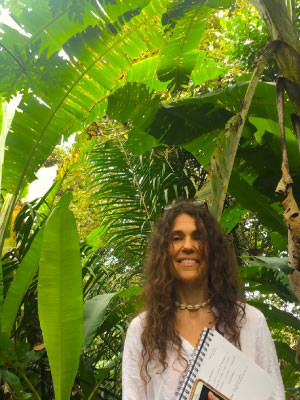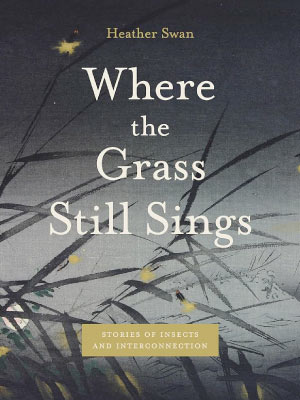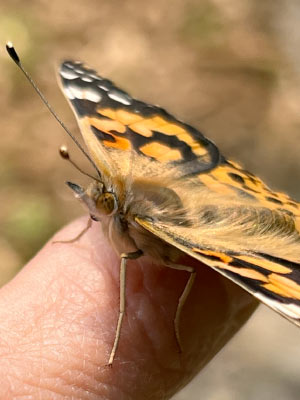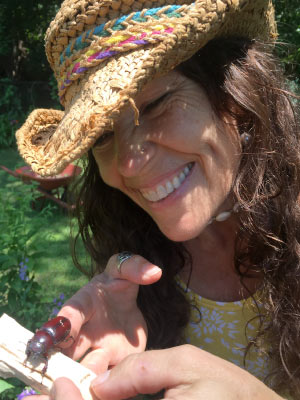
Heather Swan didn’t have the most conventional upbringing. As a girl, she lived with her mother, an artist, and traveled between artist communities across the country. “My mom was a potter, and she always solved problems in creative ways,” says Swan. “Like when we didn’t have a couch, she built one out of milk crates and plywood!” Constantly moving made it difficult for her to make friends, so Swan spent a lot of time in nature with her dog, appreciating the ecosystems and landscapes around her. “I’ve always felt that all beings — even the smallest ones, like insects — have very complicated lives. I didn’t think of myself as superior to them, but rather part of the whole kaleidoscope of beings,” she says.
In addition to having an affinity for insects, Swan was also drawn to literature. She holds a PhD in literary studies and an MFA in poetry from the University of Wisconsin–Madison, and is currently a senior lecturer with UW–Madison’s English department. She also holds a minor in environmental studies through the Nelson Institute’s Center for Culture, History, and the Environment. The intersection of her interests has led her to publish two books about the relationship between insects, humanity, and the environment. Her most recent book, Where the Grass Still Sings: Stories of Insects and Interconnection, is a companion to the award-winning Where the Honeybees Thrive: Stories from the Field, published in 2017.

Your first book explored your relationship with honeybees and the threats they’re facing. What made you branch out to other insects as well?
I realized I hadn’t focused enough on all the insects that weren’t very glamorous — such as beetles, which I’ve included in my new book. When you really start noticing insects, you’ll see that they’re truly extraordinary. Every day, miracles are happening but we don’t notice because they’re so small. Just think of metamorphosis; a little caterpillar forms a chrysalis and wakes up as a butterfly — that’s marvelous, isn’t it? Insects are so beautiful.
Do you have a favorite insect?
Ask me any day of the week, and I’ll probably have something different to say! Right now I’m fascinated by bumblebees because I feel like they’re quite strange and wonderful little beings. They’re cute, too — they’re like the panda bear of insects!
Why should people pay more attention to insects?
Insects are a foundation of entire ecosystems; If you don’t have a healthy insect population, an ecosystem will fall apart. That means if you love birds, you have to love insects. If you love mammals, you also have to love insects. If you love to eat, you have to love insects because they pollinate so many things.

If you stop and slow down to look at what’s surrounding us every single day, you’ll see that there’s so much magic and beauty out there. It’s such a complex, incredible world, and if we slow down and notice it, we’ll realize that it needs care. Attention lends to intention, and intention leads to action.
What can readers expect from your new book, Where the Grass Still Sings?
My book shows several strategies for change from entomologists, conservation biologists, farmers, museum curators, botanists, and more. It’s a collection of people I’ve met who are innovatively and creatively coming up with solutions to protect insects and our world. After spending time with these experts, I braided my own experiences with their knowledge to create a mosaic of different ways to approach a problem. But this book isn’t about me, it’s about all the amazing people I met — it’s like being the host of a really great party.

Can you tell me about your decision to include artists’ galleries in your book?
After every chapter, there’s a gallery featuring an artist whose work plays off of a theme from the chapter. For example, after the chapter where I meet with an entomologist at the Berkeley Essig Museum, I feature a gallery from Jenny Angus, who creates patterns with insects that she’s collected herself over 30 years.
I believe art affects us differently than other forms of communication. When I was in Columbia and saw some incredible murals of animal-human hybrids, I remember thinking that I could write about these murals — but it was an entirely different thing to see them. Through art, we can envision things beyond what we see right now and visualize how interconnected things are.
What do you want to accomplish through your book?
I hope to inspire people to think outside the box, and also to feel hope. I want to offer younger generations a path for change, and my book shows that change can happen, and it is happening. It’s easy to feel like what you’re doing isn’t important; that you’re just one person. But in a lot of these stories, it’s just one wonderful person causing so much change — your impact is so much bigger than you realize.